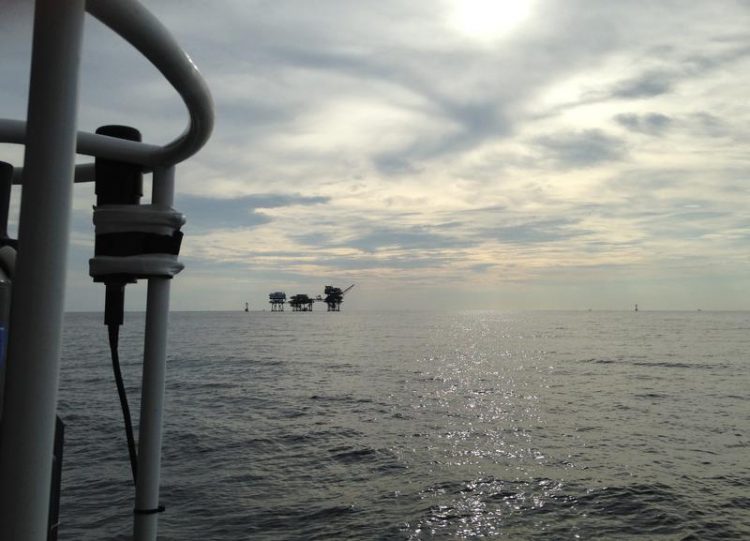Small but versatile; key players in the marine nitrogen cycle can utilize cyanate and urea

Samples for this study were taken in den Gulf of Mexico. (copyright: Max Planck Institute for Marine Microbiology/K. Kitzinger)
The Thaumarchaeota play a key role in the marine nitrogen cycle. They gain energy for growth by converting ammonia, which is the most reduced form of inorganic nitrogen, to a more oxidized form: nitrite.
These so-called ammonia oxidizing archaea were discovered little more than a decade ago, yet these organisms make up a large part of the marine microbial community, thriving in the oceans despite ammonium being present only at very low concentrations.
Even though the Thaumarchaeota are such a key part of the marine nitrogen cycle, little is known about the physiology of these small and enigmatic microorganisms.
In general, they are considered to be metabolically restricted, relying on ammonia as an energy source. A new study by Katharina Kitzinger and colleagues from the Max Planck Institute for Marine Microbiology in Bremen, Germany, the University of Vienna, Austria, the Georgia Institute for Technology, USA, the Carl von Ossietzky University Oldenburg, Germany, and the MARUM – Center for Marine Environmental Sciences in Bremen, Germany, now reveals that this is not quite true. Rather, the authors show that marine ammonia oxidizing archaea can also utilize organic nitrogen sources.
“We show for the first time that both environmental and cultured marine ammonia oxidizing archaea can use cyanate, a simple organic nitrogen compound, as an additional energy source“, Kitzinger explains.
Further, they show these microorganisms also use that urea, another organic nitrogen compound. These findings are important as cyanate and urea are common nitrogen and energy sources in the oceans. The Thaumarchaeota’s ability to supplement their metabolism with these compounds might be one reason for their outstanding success in the oceans.
Kitzinger is especially intrigued by how the marine ammonia oxidizing archaea are able to use cyanate. “We still aren’t sure exactly how they do it. They don't have the typical enzyme repertoire needed to use cyanate.
It will be exciting to see which enzymes allow marine ammonia oxidizing archaea to use cyanate, if these organisms have an even larger metabolic versatility than we know now, and how this versatility shapes their ecology”, says Kitzinger.
Participating institutes
Max Planck Institute for Marine Microbiology, Bremen, Germany
Department of Microbiology and Ecosystem Science, University of Vienna, Austria
School of Biological Sciences, Georgia Institute of Technology, Atlanta, USA
Research Group for Marine Geochemistry (ICBM-MPI Bridging Group), Institute for Chemistry and Biology of the Marine Environment, Carl von Ossietzky University, Oldenburg, Germany
Marine Archaea Group, MARUM – Center for Marine Environmental Sciences, Bremen, Germany
Questions/press office:
Dr. Fanni Aspetsberger
Max Planck Institute for Marine Microbiology
Phone: +49 421 2028 947
E-Mail: presse@mpi-bremen.de
Dr. Hannah K. Marchant
Max Planck Institute for Marine Microbiology
Phone: +49 421 2028 630
E-Mail: hmarchan@mpi-bremen.de
Katharina Kitzinger
Max Planck Institute for Marine Microbiology
Phone: +49 421 2028 646
E-Mail: kkitzing@mpi-bremen.de
University of Vienna
Department für Mikrobiologie und Ökosystemforschung
Email: kitzinger@microbial-ecology.net
Katharina Kitzinger, Cory C. Padilla, Hannah K. Marchant, Philipp F. Hach, Craig W. Herbold, Abiel T. Kidane, Martin Könneke, Sten Littmann, Maria Mooshammer, Jutta Niggemann, Sandra Petrov, Andreas Richter, Frank J. Stewart, Michael Wagner, Marcel M. M. Kuypers, Laura A. Bristow: Cyanate and Urea are Substrates for Nitrification by Thaumarchaeota in the Marine Environment. Nature Microbiology.
DOI: 10.1038/s41564-018-0316-2
Link: http://dx.doi.org/10.1038/s41564-018-0316-2
Media Contact
More Information:
http://www.mpi-bremen.deAll latest news from the category: Life Sciences and Chemistry
Articles and reports from the Life Sciences and chemistry area deal with applied and basic research into modern biology, chemistry and human medicine.
Valuable information can be found on a range of life sciences fields including bacteriology, biochemistry, bionics, bioinformatics, biophysics, biotechnology, genetics, geobotany, human biology, marine biology, microbiology, molecular biology, cellular biology, zoology, bioinorganic chemistry, microchemistry and environmental chemistry.
Newest articles

Detector for continuously monitoring toxic gases
The material could be made as a thin coating to analyze air quality in industrial or home settings over time. Most systems used to detect toxic gases in industrial or…

On the way for an active agent against hepatitis E
In order to infect an organ, viruses need the help of the host cells. “An effective approach is therefore to identify targets in the host that can be manipulated by…

A second chance for new antibiotic agent
Significant attempts 20 years ago… The study focused on the protein peptide deformylase (PDF). Involved in protein maturation processes in cells, PDF is essential for the survival of bacteria. However,…





















